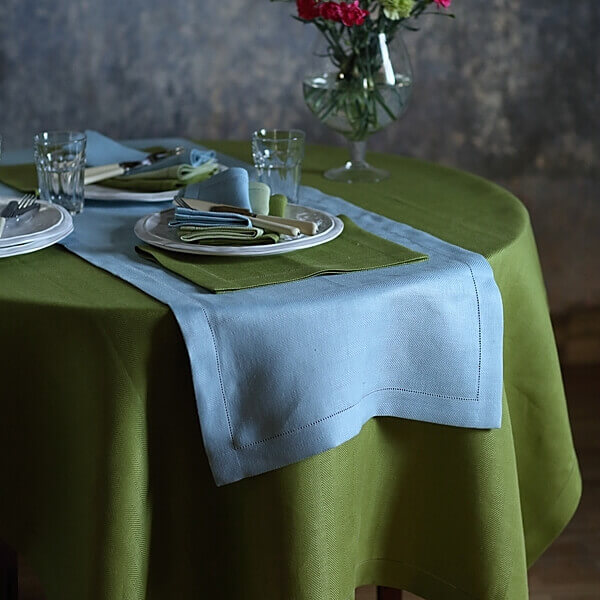Versatile Table Cloths: Styles and Fabrics for Any Occasion
Versatile Table Cloths: Styles and Fabrics for Any Occasion
Blog Article
Bed Linen Material Technologies: Discovering Modern Trends and Creative Applications in Design and Fabric Market
From sustainable manufacturing approaches to sophisticated weaving modern technologies, the development of linen is reshaping the landscape of the fabric market. As we dig into the worlds of innovative style applications and the appearance of bed linen blends and hybrid textiles, a brand-new chapter unfolds in which linen's role in future textile innovations takes center phase.
Sustainable Practices in Linen Manufacturing
Sustainable techniques in linen production have come to be increasingly essential in the textile industry's efforts to reduce environmental impact and advertise honest sourcing approaches. Bed linen, an all-natural fiber stemmed from the flax plant, supplies a range of advantages such as breathability, biodegradability, and longevity. However, traditional techniques of bed linen manufacturing can involve substantial water intake, pesticide usage, and energy-intensive procedures.
To address these challenges, lots of textile manufacturers are adopting sustainable methods throughout the bed linen manufacturing process. This includes sourcing flax from natural farms that prevent harmful chemicals and chemicals, applying water-efficient retting methods to remove fibers from the flax stalks, and using green dyes and surfaces. In addition, some firms are buying sustainable energy sources to power their production facilities and minimizing waste through recycling and upcycling efforts.
Technical Developments in Bed Linen Weaving
With the growing focus on sustainable practices in linen production, the fabric sector is now witnessing a surge in technological improvements specifically aimed at changing the art of linen weaving. These innovations are improving the means bed linen materials are produced, providing increased efficiency, top quality, and creative thinking in weaving strategies.
Among the vital technological improvements in linen weaving is the assimilation of computerized looms. These advanced looms are outfitted with software program that enables intricate and detailed styles to be woven with precision. By digitizing the weaving procedure, producers can accomplish better uniformity and accuracy in their bed linen fabrics.
Additionally, developments in thread spinning innovation have allowed the manufacturing of finer and more sturdy bed linen threads - table cloths. This causes softer and smoother linen fabrics that retain their quality even after numerous uses and washes
In addition, the growth of environmentally friendly dyeing processes and finishes for linen fabrics is gaining grip. These sustainable methods not just reduce the environmental influence however also satisfy the increasing consumer demand for morally created fabrics.
Creative Design Applications for Bed Linen
Innovative creative techniques are progressively shaping the imaginative layout applications for linen in the textile market. Linen's natural visual appeal and ability to mix with various other materials make it a favored selection for creating distinct garments and accessories that cater to the eco conscious consumer.
In addition, designers are try out bed linen in home decoration, utilizing its breathable and durable nature to craft trendy furnishings such as curtains, bedding, and upholstery. The structure and drape of bed linen bring a sense of class and convenience to indoor areas, adding a touch of sophistication to modern homes.

Bed Linen Blends and Crossbreed Fabrics

Crossbreed fabrics, on the other hand, take the idea of mixing an action even more by including extra components such as metal threads, recycled products, or conductive fibers. These innovative fabrics not only increase the design possibilities however also present useful facets like conductivity, antimicrobial buildings, or enhanced toughness. Crossbreed fabrics are increasingly being utilized in various markets, including style, interior layout, and technical fabrics, where the need for multifunctional products gets on the rise.
Bed linen's Function in Future Textile Innovations

In the realm of future fabric innovations, linen is expected to be a principal dig this in the growth of innovative address functional textiles. Scientists and designers are exploring ways to enhance linen's fundamental top qualities through technical advancements, such as integrating wise textiles, nanotechnology, and efficiency finishes. These technologies aim to boost linen's efficiency attributes, making it appropriate for a more comprehensive series of applications, from activewear to protective garments.
Furthermore, the mix of bed linen with various other all-natural or artificial fibers opens unlimited possibilities for creating novel fabrics with distinct homes and functionalities. By leveraging bed linen's qualities and discovering cutting-edge blends, the textile industry is poised to introduce exciting developments that deal with evolving customer demands and sustainability demands.
Final Thought
To conclude, the exploration of lasting practices, technological advancements, imaginative design applications, linen blends, and its role in future textile innovations highlight the constant development of bed linen material in the modern-day layout and textile market. With a focus on development and creativity, the adaptability and environment-friendly nature of bed linen make it an important material for designers and suppliers alike, paving the way for more advancements and developments in the field of fabrics.
As we delve right into the worlds of innovative design applications and the introduction of linen blends and crossbreed textiles, a brand-new phase unravels in which bed linen's function in future fabric advancements takes facility phase.
Exploring the blend of bed linen with other materials has led to the development of ingenious blends and hybrid fabrics in the modern textile market. Bed linen blends use an one-of-a-kind mix of the qualities of bed linen with those of other fibers, resulting in fabrics that have enhanced homes such as increased sturdiness, boosted draping, and lowered wrinkling.The advancement of linen blends and crossbreed fabrics has established the phase for Bed linen to play a pivotal duty in driving future textile developments.In the world of future fabric developments, linen is expected to be a crucial player in the development of innovative functional fabrics.
Report this page